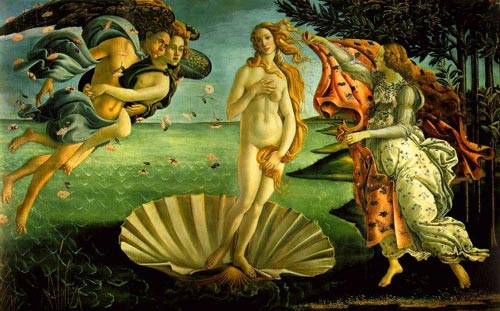Birth of Venus
Revision as of 17:15, 12 May 2007 by WikiAdmin (Talk | contribs) (New page: center '''The Birth of Venus'''<br /> Sandro Botticelli (1444-1510) :"This charming Virgin [...] was the ancient pagan Sea-goddess Marian [...] A familiar...)
The Birth of Venus
Sandro Botticelli (1444-1510)
- "This charming Virgin [...] was the ancient pagan Sea-goddess Marian [...] A familiar disguise of this same Marian is the merry-maid, as 'mermaid' was once written. The conventional figure of the mermaid--a beautiful woman with a round mirror, a golden comb and a fish-tail — expresses 'The Love-goddess rises from the Sea'. Botticelli's Birth of Venus is an exact icon of her cult. Tall, golden-haired, blue-eyed, pale-faced, the Love-goddess arrives in her scallop-shell at the myrtle-grove, and Earth, in a flowery robe, hastens to wrap her in a scarlet gold-fringed mantle."
- Robert Graves, from The White Goddess, pp.394-95
Wikipedia on the Birth of Venus (general)
Wikipedia on Botticelli's painting
From An article by Cole Bertsch:
- Botticelli's work The Birth of Venus is a journey back into the time of mythology and the roots of creation. This piece was commissioned to be painted for the powerful Medici family of Florence. Never before had a family been able to acquire so much wealth and prestige from such obscure beginnings. Their power rooted from the marriage of royalty in Europe alongside the determination to succeed. Their origins are unknown, but did produce three popes, two queens of France and several cardinals of the Roman Catholic Church. With their strength and influence over the people, they obviously wanted an established, well-known painter to adorn the walls of a Florentine villa with beautiful creations. The Medici's chose Sandro Boticelli to accomplish this.
- As the Renaissance was a time of revisiting the past in search of answers for the future, the mythology of the Greeks and Romans was admired as much more than just pretty fairy-tales. The people saw the effects of the Middle Ages and the dreary accomplishments that time period made, and were convinced that the ancients were a much wiser people. To revert back to these glory days, the Medici?s of Florence sought an artist to express the tale of the Birth of Venus onto canvas to hang in the villa of Florence. Scholars told Botticelli the story of her birth was the symbol of mystery through which the divine message of beauty came into the world. It is obvious that Botticelli took great pride in trying to accomplish the work without skewing the actual story of the myth. Venus has emerged from the sea on a shell which is carried to the shore by flying wind-gods amidst a shower of roses. As she is about to step onto the land, one of the Nymphs receives her with a purple cloak. This earthly work was painted onto canvas, which was a less expensive painting surface than the wooden panels used in church and court pictures. A wooden surface would certainly be impractical for a work on such a scale. Canvas was the preferred material for the painting of nonreligious and pagan subjects commissioned to decorate country villas in 15th-century Italy.
